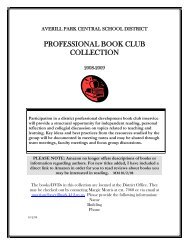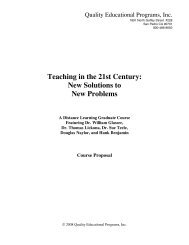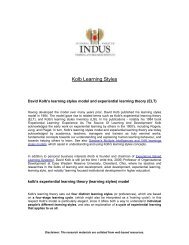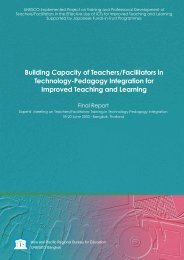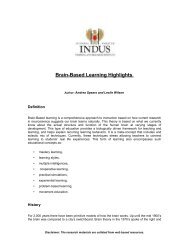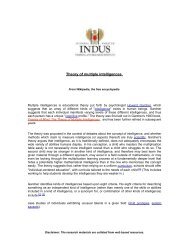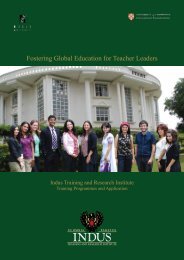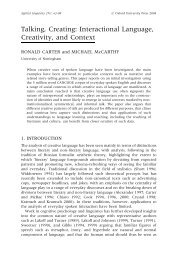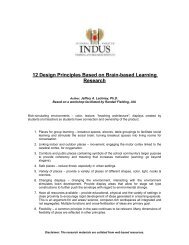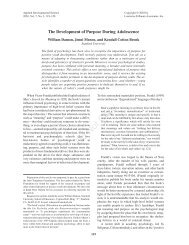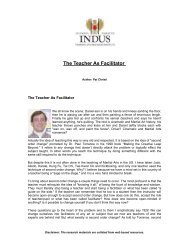Primary Years Programme Making the PYP happen - ITARI
Primary Years Programme Making the PYP happen - ITARI
Primary Years Programme Making the PYP happen - ITARI
- No tags were found...
Create successful ePaper yourself
Turn your PDF publications into a flip-book with our unique Google optimized e-Paper software.
<strong>Making</strong> <strong>the</strong> <strong>PYP</strong> <strong>happen</strong><br />
Good ma<strong>the</strong>matics practice<br />
What is a <strong>PYP</strong> ma<strong>the</strong>matics classroom like<br />
In a <strong>PYP</strong> classroom ma<strong>the</strong>matics is a vital and engaging part of students’ lives. The children in <strong>the</strong> room are<br />
very active, with an underlying sense of organization and cooperation. Teachers and students are asking<br />
questions of each o<strong>the</strong>r, trying out and demonstrating ideas in small and large groups, using <strong>the</strong> language of<br />
ma<strong>the</strong>matics to describe <strong>the</strong>ir thinking, generating data to look for patterns and making conjectures. A wide<br />
variety of materials is available to all. These manipulatives are constantly in use. There are lists, tables and<br />
charts on display showing written and numerical data about which relevant questions are asked and<br />
answered.<br />
The number of ma<strong>the</strong>matics resources available is impressive: colourful and thought-provoking posters and<br />
children’s work cover <strong>the</strong> walls; materials, ranging from student collections of keys, foreign money and<br />
seashells to store-bought pattern blocks and geoboards, are out on tables; everyday tools, such as measuring<br />
jugs, calculators, even cereal boxes, are in use. On <strong>the</strong> bookshelves are many resource books for <strong>the</strong> teacher<br />
and students, including a wide variety of textbooks, ma<strong>the</strong>matical dictionaries and encyclopedias and<br />
children’s literature, which focus on ma<strong>the</strong>matical ideas. The computer area is well stocked with innovative<br />
software that encourages <strong>the</strong> application of ma<strong>the</strong>matics skills and problem solving and <strong>the</strong> general supplies<br />
area has a variety of paper for recording ma<strong>the</strong>matical ideas: different sized squared paper, dot paper and much<br />
scribble paper. There may even be a video area where high quality video tapes show how ma<strong>the</strong>matics is used<br />
outside <strong>the</strong> classroom. It is clear where things belong and how <strong>the</strong>y are used.<br />
The ma<strong>the</strong>matics classroom does not work on its own. The students visit younger children to help <strong>the</strong>m with<br />
<strong>the</strong>ir investigations. Students also work with older children to travel about town in small groups on a treasure<br />
hunt, asking and answering questions about dates, times, distance, prices and more. O<strong>the</strong>r teachers and<br />
parents come to share <strong>the</strong>ir interests and expertise. The school nurse and administrators are involved in<br />
providing information and participating in surveys. The school’s parking lot and local shops are visited when<br />
collecting data. The community at large provides innumerable opportunities for budding ma<strong>the</strong>maticians to<br />
practise <strong>the</strong>ir craft.<br />
How does a <strong>PYP</strong> ma<strong>the</strong>matics classroom work<br />
Inquiry-based units of study are <strong>the</strong> entry points into ma<strong>the</strong>matics learning through which students will<br />
experience what it is like to think and act as ma<strong>the</strong>maticians. Students and teachers identify toge<strong>the</strong>r what <strong>the</strong>y<br />
already know which might be relevant to <strong>the</strong> inquiry, what <strong>the</strong>y want to know, what <strong>the</strong>y need to know to<br />
answer <strong>the</strong>ir questions and how best <strong>the</strong>y might find that out.<br />
The <strong>PYP</strong> ma<strong>the</strong>matics teacher is well trained in primary ma<strong>the</strong>matics. Personal knowledge of <strong>the</strong> subject<br />
matter is of primary importance. The teacher’s own interest in and development of <strong>the</strong> discipline is<br />
maintained through regular inservice, reading professional journals and, especially, regular contact with<br />
colleagues who share <strong>the</strong> commitment to teaching ma<strong>the</strong>matics through inquiry.<br />
With <strong>the</strong> curriculum as <strong>the</strong> guide, <strong>the</strong> teacher spends time in different ways: walking about while students<br />
are working alone, in pairs, in small groups or even as a whole class; asking key questions; challenging <strong>the</strong><br />
students’ thinking—prompting <strong>the</strong>m to take ideas one step fur<strong>the</strong>r; and jotting down notes to inform <strong>the</strong><br />
next stages of learning. The teacher might also ga<strong>the</strong>r a group of students with a particular interest or<br />
problem to provide more specific help through guidance and practising toge<strong>the</strong>r.<br />
One of <strong>the</strong> most important aspects of <strong>the</strong> teacher’s role is to encourage appropriate ma<strong>the</strong>matical discussion<br />
among <strong>the</strong> student ma<strong>the</strong>maticians—demonstrating <strong>the</strong> nature of ma<strong>the</strong>matical discourse and <strong>the</strong><br />
development of conjectures. Students follow simple, polite rules when talking with each o<strong>the</strong>r, building on<br />
previously mentioned ideas, supporting o<strong>the</strong>rs in <strong>the</strong> various stages of learning and sharing <strong>the</strong>ir discoveries<br />
in a congenial atmosphere. Students see writing down <strong>the</strong>ir ideas as a natural step in <strong>the</strong> process of<br />
communicating important ideas. They record in a variety of ways, including drawing pictures, recording<br />
numbers and writing in ma<strong>the</strong>matics journals.<br />
78 © IBO 2000



